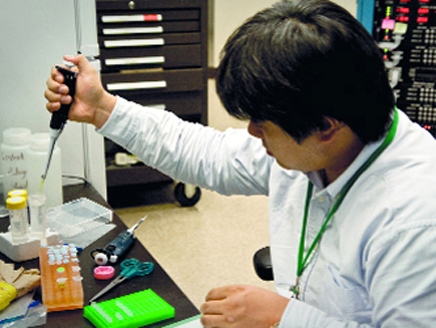باحثون يابانيون يبتكرون خلايا قاتلة للسرطان
يتم اشتقاقها اصطناعيًا من خلايا غير متعددة القدرات

تمكّن باحثون يابانيون من تحقيق إنجاز في عالم الأبحاث السرطانية، بعد أن ابتكروا خلايا قاتلة لمرض السرطان يمكن حقن المرضى مباشرة بها. وفقاً لصحيفة "الخليج الإماراتية".
وذكرت دراسة نشرت في دورية (سيل ستام سيل) العلمية، أن الباحثين بمركز "رايكن" الياباني لأبحاث الحساسية وعلم المناعة، تمكنوا من ابتكار ما يعرف بالخلايا التائية المتخصصة بقتل الخلايا السرطانية.
وقال الباحثون الذين يترأسهم الطبيب، هيروشي كاواموتو، إن هذه الخلايا موجودة بأعداد قليلة في الجسم، غير أنهم أعربوا عن أملهم بأن يساهم حقن المريض بكميات كبيرة منها في تحسين أداء جهازه المناعي.
وبهدف ابتكار هذه الخلايا، عمد فريق الباحثين أولاً إلى إعادة برمجة الخلايا التائية المتخصصة في قتل نوع معين من السرطان، لجعلها نوعاً آخر من الخلايا تدعى الخلايا الجذعية المستحثة المتعددة القدرات (وهي نوع من الخلايا الجذعية التي يتم اشتقاقها اصطناعيًا من خلايا غير متعددة القدرات، تكون عادة خلايا جسدية بالغة، وذلك من خلال حثها على التعبير عن موروثات معينة)، أنتجت بدورها خلايا تائية ناشطة متخصصة بمكافحة السرطان.
لكن أبحاثاً سابقة أظهرت أن الخلايا التائية القاتلة المصنّعة في المختبر من خلال وسائل تقليدية، غير كافية لقتل الخلايا السرطانية، بسبب قصر أمد حياتها الذي يحدّ من استخدامها كعلاج للسرطان.
ولذلك، قام الباحثون اليابانيون، بهدف تفادي هذه المشكلة، بإعادة برمجة الخلايا التائية القاتلة البالغة لجعلها خلايا جذعية مستحثة متعددة القدرات، وأجروا بعدئذٍ مقارنة بينها، فتبيّن أنها متخصصة بسرطان الجلد عينه الذي كانت الخلايا الأساسية متخصصة به.
ووجدوا أن الخلايا الجديدة لديها إعادة الترتيب الوراثية نفسها التي لدى الخلايا الأساسية، ما أتاح لها التعبير عن مستقبلات لخلايا السرطان على سطحها، كما تبيّن أنها فاعلة ومنتجة لمركّب مضاد للأورام.
ومن جهته، قال الطبيب كوماياتو إن "الخطوة التالية هي اختبار ما إذا كان بإمكان هذه الخلايا التعرف على الخلايا السرطانية وقتلها من دون سواها من خلايا الجسم".
وتابع أنه "في حال صح ذلك، يمكن حقن هذه الخلايا مباشرة في المرضى لعلاجهم (من السرطان)"، مؤكداً أنه "أمر يمكن تحقيقه في المستقبل غير البعيد".
والتقرير باللغه الانجليزيه
Japanese researchers to devise deadly cancer cells
Japanese researchers to devise deadly cancer cells
Are derived from multiple cells artificially capacity

Japanese researchers were able to accomplish in the world of cancer research, after creating deadly cancer cells could be injected into patients directly. According to the UAE Gulf. "
According to a study published in the journal (torrent Stamm upsell) scientific researchers "raikn" Center for allergy and immunology research, managed to invent so-called t cells specialized in killing cancer cells.
Researchers who led the doctor, Hiroshi Kawamoto, that these cells are present in small numbers in the body, but they expressed hope that the injection the patient large quantities to improve the performance of its immune system.
In order to create these cells, the first group of researchers to reprogram t cells specialized in killing a specific type of cancer, to make it another type of cells called stem cells induced multiple capacities (a type of stem cells that are derived from multiple satellite capacity, cells are usually great, and somatic cells through to express their heritage), which in turn produced an active t cells specialized in the fight against cancer.
But previous research has shown that the killer t cells manufactured in the laboratory through traditional means, but enough to kill the cancer cells, due to the short duration of their lives, limiting their use as a treatment for cancer.
Therefore, the Japanese researchers, in order to avoid this problem, reprogramming t cells to make them deadly stem cells induced multiple capabilities, and then compare them, it turned out to be skin cancer specialist sample that was basic specialized cells.
They found that the new cells have the same genetic rearrangement of the cells, allowing them to express receptors on the surface of cancer cells, it also proved to be effective and productive to composite against tumors.
For his part, komayato said that "the next step is to test whether these cells recognize cancer cells and kill her without other cells of the body."
"If true, these cells can be injected directly into the patients for treatment (cancer)," he said, adding that it "could be achieved in the not too distant future".


